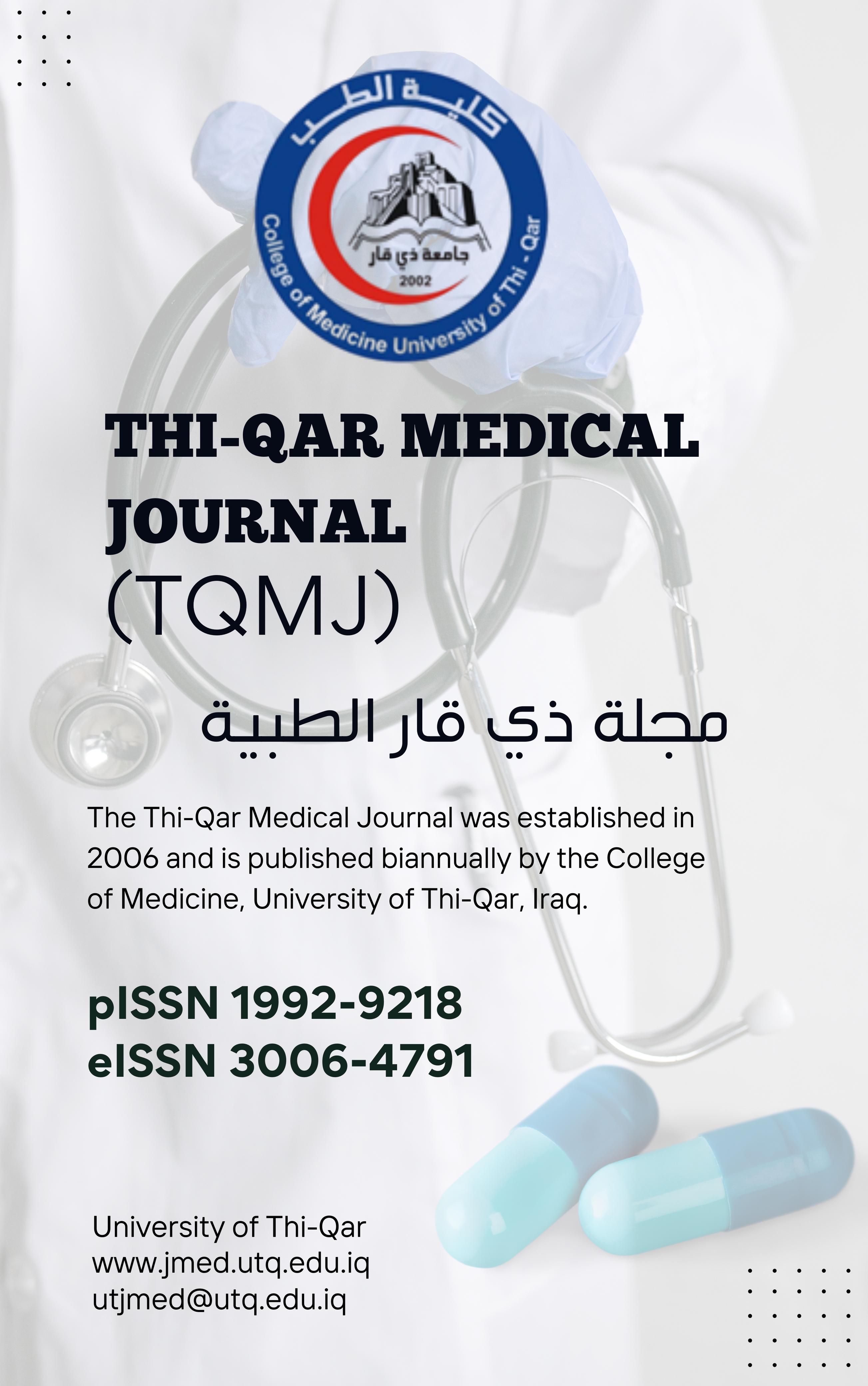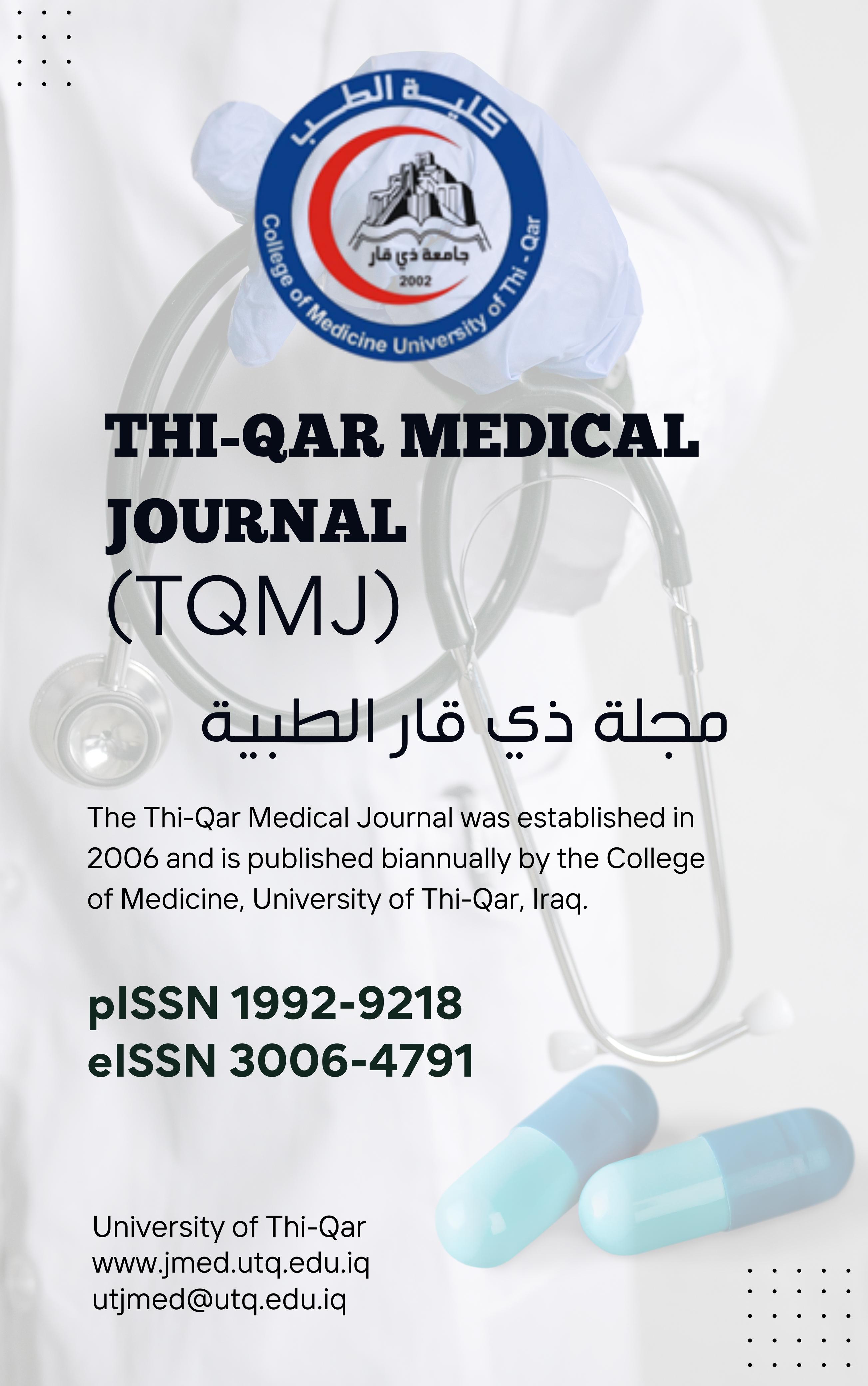Cytotoxicity and DNA binding of Manganese (II) complex Containing pyridine ligand
DOI:
https://doi.org/10.32792/jmed.2025.29.5Keywords:
Mn (II), 2-acetyl-6-bromopyridine, oxime, DNA interaction, cytotoxicity, anticancerAbstract
The interaction between large biomolecules and ligands has attractedconsiderable interest due to its biological properties. Calf thymus DNA
(CT-DNA) can interact with biologically active compounds to form
complexes. DNA is a primary target for anticancer drugs that are
involved in important cellular processes.The ligand and the manganese
complex MnCl2 (2-acetyl-6-bromopyridine oxime)2 were synthesized.
The ligand was examined using infrared spectroscopy, CHN, 1HNMR,
and 13CNM techniques. CHN elemental analysis and infrared
spectroscopy were also used to analyze the complex.Both compound 1
and the ligand demonstrated cross-linking with calf thymus DNA (CT
DNA), and the complex demonstrated higher binding efficiency than the
ligand alone. The in vitro toxicity of compound 1 was evaluated using
metabolic assays using 3-(4,5-dimethylthiazol-2-yl)-2,5
diphenyltetrazolium bromide as an anticancer agent against esophageal
cancer cells (SKGT-4). In SKGT-4 cells, the compound showed a
significant inhibitory effect. Therefore, it could be proposed as a future
anticancer drug due to its low cytotoxicity.
References
Sguizzato, M., et al., Manganese in diagnostics: a preformulatory study. Pharmaceutics, 2022. 14(1): p. 108.
https://doi.org/10.3390/pharmaceutics14010108
Odularu, A.T., MThe intrinsic binding constant Kb was estimated using the following equation [9] based on the change
in absorbance with an increase in the amount of CT DNA. The formula is:anganese Schiff base complexes,
crystallographic studies, anticancer activities, and molecular docking. Journal of Chemistry,2022.2022.
https://doi.org/10.1155/2022/7062912
Heinze, K., Made with manganese. Nature Chemistry, 2021. 13(10): p. 926-928. https://doi.org/10.1038/s41557-02100785-0
Dippong, T., E.A. Levei, and O. Cadar, Recent advances in synthesis and applications of mfe2o4 (m= co, cu, mn, ni, zn)
nanoparticles. Nanomaterials, 2021. 11(6): p. 1560.
characterization,
Al-Yaseen, A.A. and M.A. Hussein, The first type of binuclear copper complex with terminal sulfide: synthesis, structural
and cytotoxicity evaluation. Journal of Sulfur Chemistry, 2024: p. 1. https://doi.org/10.1080/17415993.2024.2416237 33
Thi-Qar Medical Journal (TQMJ)
Wei, Z., S. Abbaspour, and R. Tayebee, Nickel nanoparticles originated from cressa leaf extract in the preparation of a
novel Melem@ Ni-HPA photocatalyst for the synthesis of some chromenes and a preliminary MTT assay on the
anticancer activity of the nanocomposite. Polycyclic Aromatic Compounds, 2023. 43(1): p. 552-571.
https://doi.org/10.1080/10406638.2021.2019063
Goudarziafshar, H., et al., Template synthesis, DNA binding, antimicrobial activity, Hirshfeld surface analysis, and 1D
helical supramolecular structure of a novel binuclear copper (II) Schiff base complex. RSC advances, 2022. 12(22): p. 13580-13592. https://doi: 10.1039/d2ra00719c
Aderinto, S.O., et al., Iridium (III)-based minor groove binding complexes as DNA photocleavage agents. Dalton
Transactions, 2024. 53(17): p. 7282-7291. https://doi.org/ 10.1039/d4dt00171k
Hussein, M.A. and A.A. Yaseen, New binuclear Cu (II) complex: synthesis, structural elucidation, cytotoxic and DNA
binding evaluation. Transition Metal Chemistry, 2024. 49(1): p. 53-62. https://doi.org/10.1007/s11243-023-00561-8
Abdel-Rahman, L.H., et al., Novel Bromo and methoxy substituted Schiff base complexes of Mn (II), Fe (III), and Cr
(III) for anticancer, antimicrobial, docking, and ADMET studies. Scientific reports, 2023. 13(1): p. 3199. https://doi.org/
1038/s41598-023-29386-2. Shahabadi, N., S. Fatahi, and M. Maghsudi, Synthesis of a new Pt (II) complex containing valganciclovir drug and calf thymus DNA interaction study using multispectroscopic methods. Journal of Coordination Chemistry, 2018. 71)2: (p.
-270. https://doi.org/10.1080/00958972.2018.1433828
Ali, A., et al., Ligand substituent effect on the cytotoxicity activity of two new copper (ii) complexes bearing 8
hydroxyquinoline derivatives: Validated by MTT assay and apoptosis in MCF-7 cancer cell line (human breast cancer).
RSC advances, 2021. 11(24): p. 14362-14373. https://dio: 10.1039/D1RA00172H
Downloads
Published
Issue
Section
License
Copyright (c) 2025 Alaa A. Al-Yaseen, Mouayed A. Hussein

This work is licensed under a Creative Commons Attribution 4.0 International License.





